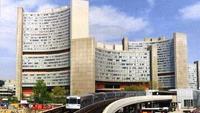In the early sixties the municipal budget reflected a clear refocusing of policies. Greater attention was paid to the extension of public transport and welfare programmes, particularly in the health sector. In 1966 the Vienna City Council approved plans for the construction of an Underground system. The first line, running north-south, was opened in 1978. Meanwhile the Underground system has become quite extensive, linking the northern Danube bank with the southern periphery and operating also a very powerful east-west link across the city. In the hospital sector, the landmark event has been the new construction of the Allgemeines Krankenhaus, or General Hospital. Its construction has not been without problems. The philosophy of building huge hospitals of this kind has come under fire, too. Medical care in the neighbourhoods north of the Danube has improved dramatically since the completion - at a fairly late point - in the 1990s of the "Socio-Medical Centre East".
International organisations

A new awareness has arisen not only with respect to the urban environment. More and more attention has also been paid in recent decades to preserving the priceless architectural heritage of the city. This has resulted in a number of rehabilitation and regeneration programmes in the densely built-up old inner-city areas. In this context valuable assistance for certain neighbourhoods has also been provided by the Federal Office for Monument Protection, through programmes aimed at protecting architectural "ensembles". Large building projects which have been launched since 1945/55 have had a dramatic impact on urban development. They have included the redesign virtually from scratch of the Danube riverfront, the first such radical change since 1875. In 1972 new construction programmes were embarked upon. A new river bed was excavated in the inundation area, i.e. a wide strip of riverfront on the northern bank, and a man-made island, the so-called Danube Island, created. This made it possible not only to contain the constant threat of flooding but also to open up an entirely new recreation area for the urban population.
Closely linked to this redesign of the riverfront is the construction of the UN Centre on the northern bank of the Danube. As early as the 1950s the first of a number of international organisations set up its headquarters in Vienna (1956: IAEO; 1965: OPEC; 1967: UNIDO). With the inauguration of theUN building on the northern bank in 1979 and the International Conference Centre a little later, Vienna established itself as one of the three UN headquarters, alongside New York and Geneva.
European Union
These aforementioned developments of the recent decades have brought the city full circle to its earlier history and its renewed position not only as a supra-regional but also as an international centre. The chemistry of all this has yet again changed in the recent past. When the Iron Curtain was in place, Vienna served as a bridge between the West and the Communist countries of Eastern Europe. This role became obsolete in 1989. Consequently Vienna's significance has somewhat diminished. The city must now try to hold its ground against such tough competitors as Prague or Budapest. On the other hand, membership in the European Union since 1995 has flung open a new gate, namely the embracing of the country and the city in what was originally an economic and is now an increasingly political community.
This article has been submitted by Wien.at .

